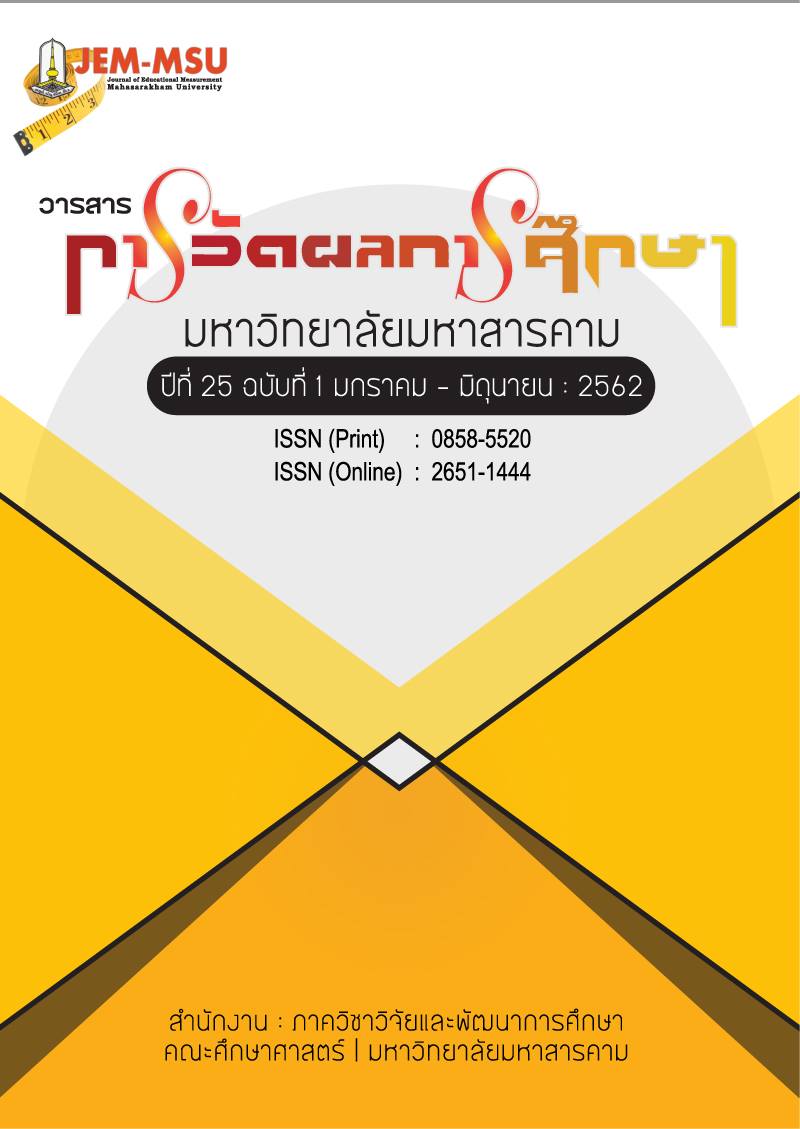Development of Grade Nine Student’s Mathematical Thinking by Using An Instructional Process to Promote Mathematical Thinking
Main Article Content
Abstract
This research purpose was to compare mathematical thinking of two groups of students in grade 9, the group that studied by using an instructional process to promote student’s mathematical thinking, and the group that studied by using normal instructional process. The sample consisted of 68 grade 9 students from Khaosamingwitthayakhom “Jongjinrujirawongupatham” School under the Secondary Education Service Area Office 17, Trat Province. The independent variables were the instructional processes which were the instructional process to promote student’s mathematical thinking and the normal instructional process; while the dependent variables were the 5 components of mathematical thinking: mathematical problem solving, mathematical reasoning and proof, mathematical communication, mathematical connections, and mathematical representation. The research instruments were a mathematical thinking test, lesson plans basing on the instructional process to promote student’s mathematical thinking, and lesson plans basing on the normal instructional process. The analysis of covariance (ANCOVA) and multivariate analysis of covariance (MANCOVA) employed ready-made computer programs.
The results revealed that the students who studied by using the instructional process to promote student’s mathematical thinking had their mathematical thinking higher than those who studied by using normal instructional process, with statistical significance at the .05 level in all 5 components.
Article Details
The content and information contained in the published article in the Journal of Educational Measurement Mahasarakham University represent the opinions and responsibilities of the authors directly. The editorial board of the journal is not necessarily in agreement with or responsible for any of the content.
The articles, data, content, images, etc. that have been published in the Journal of Educational Measurement Mahasarakham University are copyrighted by the journal. If any individual or organization wishes to reproduce or perform any actions involving the entirety or any part of the content, they must obtain written permission from the Journal of Educational Measurement Mahasarakham University.
References
กนิษฐ์ ศรีเคลือบ. (2557). การพัฒนาโมเดลการเสริมสร้างบรรยากาศการเรียนรู้ที่มีประสิทธิผล: การวิจัยอิงการออกแบบและการวิเคราะห์เอ็มเอ็มเอสอีเอ็ม. วิทยานิพนธ์ปริญญาครุศาสตรดุษฎีบัณฑิต สาขาวิชาวิธีวิทยาการวิจัยการศึกษา บัณฑิตวิทยาลัย จุฬาลงกรณ์มหาวิทยาลัย.
เกษณีย์ ยอดไฟอินทร์. (2556). ผลของการจัดกิจกรรมการเรียนรู้คณิตศาสตร์โดยใช้โมเดลเฟสเมท็อดคอมบิเนชันและยุทธ์การพัฒนาความคิดทางคณิตศาสตร์ที่มีต่อความสามารถในการให้เหตุผลและการนึกภาพทางคณิตศาสตร์ของนักเรียนชั้นมัธยมศึกษาปีที่ 3. วิทยานิพนธ์ปริญญาครุศาสตรมหาบัณฑิต สาขาวิชาการศึกษาคณิตศาสตร์ บัณฑิตวิทยาลัย จุฬาลงกรณ์มหาวิทยาลัย.
ชนาธิป พรกุล. (2554). การสอนกระบวนการคิด: ทฤษฎีและการนำไปใช้. พิมพ์ครั้งที่ 2. กรุงเทพฯ:สำนักพิมพ์แห่งจุฬาลงกรณ์มหาวิทยาลัย.
บรรจง อมรชีวิน. (2554). Thinking School สอนให้คิด. กรุงเทพฯ: ภาพพิมพ์.เบญจมาศ ฉิมมาลี. (2550). ผลการจัดกิจกรรมคณิตศาสตร์โดยใช้คำถามระดับสูงประกอบแนวทางพัฒนาความคิดทางคณิตศาสตร์ของฟรายวิลลิกที่มีต่อความสามารถในการแก้ปัญหาคณิตศาสตร์และการคิดอย่างมีวิจารณญาณของนักเรียนชั้นมัธยมศึกษาปีที่ 3. วิทยานิพนธ์ปริญญาครุศาสตรมหาบัณฑิต สาขาวิชาการศึกษาคณิตศาสตร์ บัณฑิตวิทยาลัย จุฬาลงกรณ์มหาวิทยาลัย.
รุ่งทิวา นาบำรุง. (2550). วิถีธรรมชาติแห่งการคิดเชิงคณิตศาสตร์เรื่องการคูณและการหารของเด็กที่มีอายุตั้งแต่ 7 – 10 ปี. ปริญญานิพนธ์ปริญญาการศึกษาดุษฎีบัณฑิต สาขาวิชาคณิตศาสตร์ศึกษา บัณฑิตวิทยาลัย มหาวิทยาลัยศรีนครินทรวิโรฒ.
Fraivillig, J. (2001). Strategies For Advancing Children's Mathematical Thinking. Teaching Children Mathematics, 8(7), 454-459.
Greenwood, J. J. (1993). On the Nature of Teaching and Assessing ‘Mathematical Power’ and ‘Mathematical Thinking’. Arithmetic Teacher, 41(3), 144-152.
National Council of Teachers of Mathematics. (2000). Principle and Standards for School Mathematics. USA: NCTM.


